Report on Health, Well-being, and Community Services: An Overview
VerifiedAdded on 2022/12/19
|14
|3916
|52
Report
AI Summary
This report provides a comprehensive overview of health, well-being, and community services, focusing on trauma-informed care (TIC) and evidence-based practices. It explores the values, principles, and features of TIC, emphasizing safety, trustworthiness, choice, collaboration, and empowerment. The report addresses the importance of gender considerations in trauma, documentation procedures, and evaluation methods for services. It details referral processes, follow-up strategies, and the creation of trauma-informed approaches to care, including organizational and clinical level changes. The report also covers service evaluation, staff training, and the identification of policies contributing to traumatization. Furthermore, it examines patient involvement in treatment, discusses key issues in trauma-informed sessions, and provides strategies for individual self-care and creating safe environments. The report concludes with a case study, applying TIC principles to improve the well-being of an individual named Anh, addressing emotional safety, strength-based approaches, and therapist self-care to prevent re-traumatization. It also outlines the behavior change model used in trauma-informed care and conflict resolution strategies.

Health, Well being
and Community
Services
and Community
Services
Paraphrase This Document
Need a fresh take? Get an instant paraphrase of this document with our AI Paraphraser
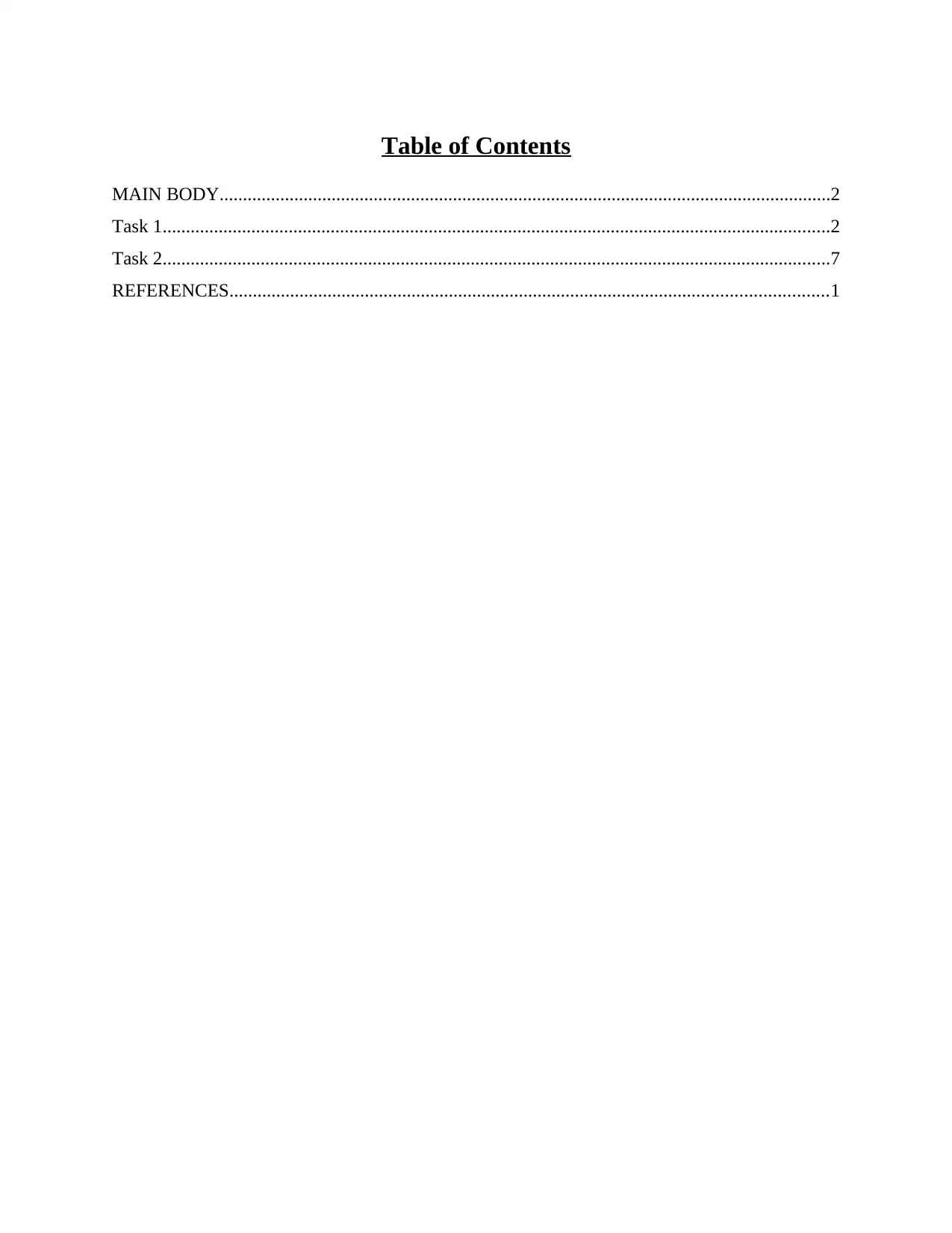
Table of Contents
MAIN BODY...................................................................................................................................2
Task 1...............................................................................................................................................2
Task 2...............................................................................................................................................7
REFERENCES................................................................................................................................1
MAIN BODY...................................................................................................................................2
Task 1...............................................................................................................................................2
Task 2...............................................................................................................................................7
REFERENCES................................................................................................................................1
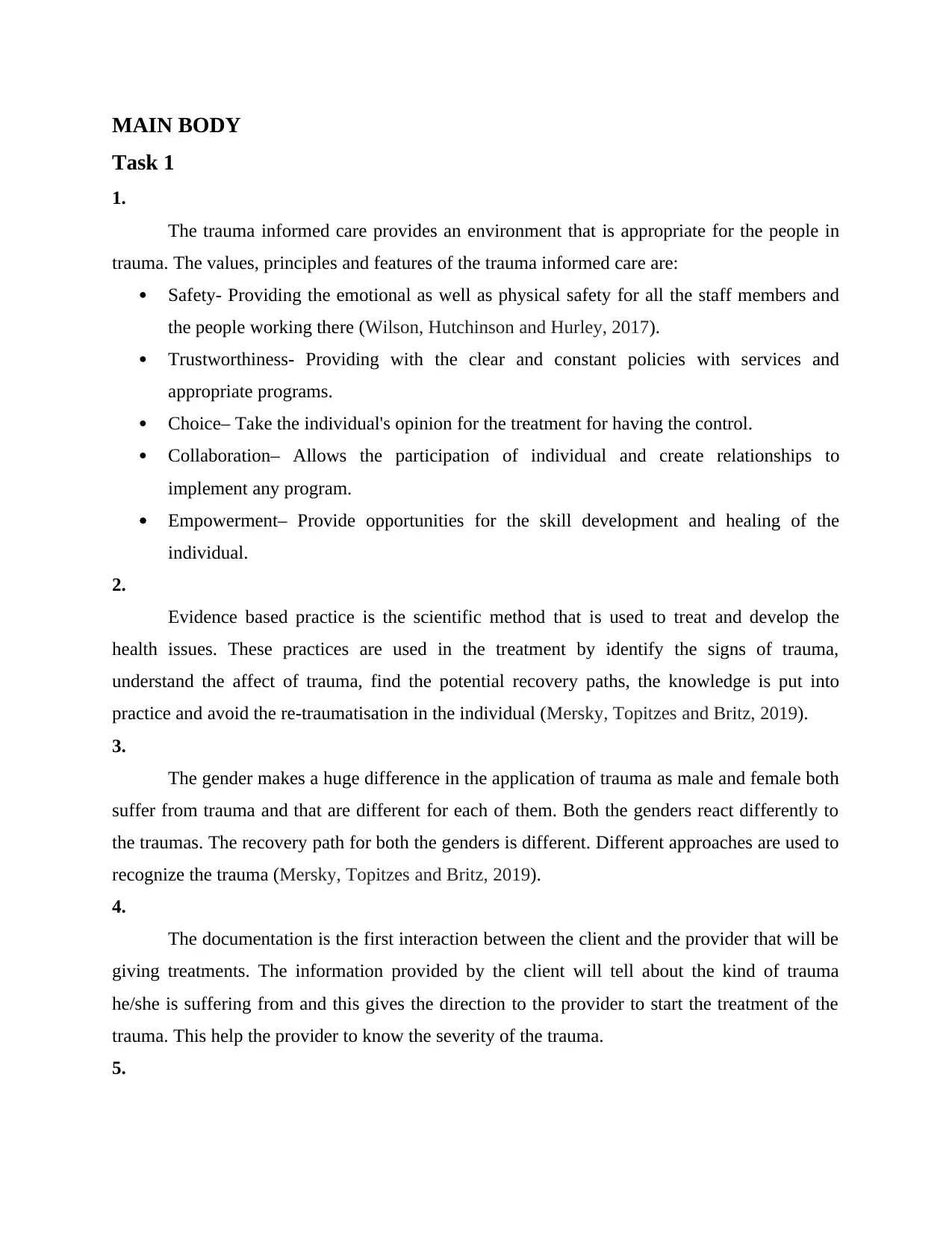
MAIN BODY
Task 1
1.
The trauma informed care provides an environment that is appropriate for the people in
trauma. The values, principles and features of the trauma informed care are:
Safety- Providing the emotional as well as physical safety for all the staff members and
the people working there (Wilson, Hutchinson and Hurley, 2017).
Trustworthiness- Providing with the clear and constant policies with services and
appropriate programs.
Choice– Take the individual's opinion for the treatment for having the control.
Collaboration– Allows the participation of individual and create relationships to
implement any program.
Empowerment– Provide opportunities for the skill development and healing of the
individual.
2.
Evidence based practice is the scientific method that is used to treat and develop the
health issues. These practices are used in the treatment by identify the signs of trauma,
understand the affect of trauma, find the potential recovery paths, the knowledge is put into
practice and avoid the re-traumatisation in the individual (Mersky, Topitzes and Britz, 2019).
3.
The gender makes a huge difference in the application of trauma as male and female both
suffer from trauma and that are different for each of them. Both the genders react differently to
the traumas. The recovery path for both the genders is different. Different approaches are used to
recognize the trauma (Mersky, Topitzes and Britz, 2019).
4.
The documentation is the first interaction between the client and the provider that will be
giving treatments. The information provided by the client will tell about the kind of trauma
he/she is suffering from and this gives the direction to the provider to start the treatment of the
trauma. This help the provider to know the severity of the trauma.
5.
Task 1
1.
The trauma informed care provides an environment that is appropriate for the people in
trauma. The values, principles and features of the trauma informed care are:
Safety- Providing the emotional as well as physical safety for all the staff members and
the people working there (Wilson, Hutchinson and Hurley, 2017).
Trustworthiness- Providing with the clear and constant policies with services and
appropriate programs.
Choice– Take the individual's opinion for the treatment for having the control.
Collaboration– Allows the participation of individual and create relationships to
implement any program.
Empowerment– Provide opportunities for the skill development and healing of the
individual.
2.
Evidence based practice is the scientific method that is used to treat and develop the
health issues. These practices are used in the treatment by identify the signs of trauma,
understand the affect of trauma, find the potential recovery paths, the knowledge is put into
practice and avoid the re-traumatisation in the individual (Mersky, Topitzes and Britz, 2019).
3.
The gender makes a huge difference in the application of trauma as male and female both
suffer from trauma and that are different for each of them. Both the genders react differently to
the traumas. The recovery path for both the genders is different. Different approaches are used to
recognize the trauma (Mersky, Topitzes and Britz, 2019).
4.
The documentation is the first interaction between the client and the provider that will be
giving treatments. The information provided by the client will tell about the kind of trauma
he/she is suffering from and this gives the direction to the provider to start the treatment of the
trauma. This help the provider to know the severity of the trauma.
5.
⊘ This is a preview!⊘
Do you want full access?
Subscribe today to unlock all pages.

Trusted by 1+ million students worldwide
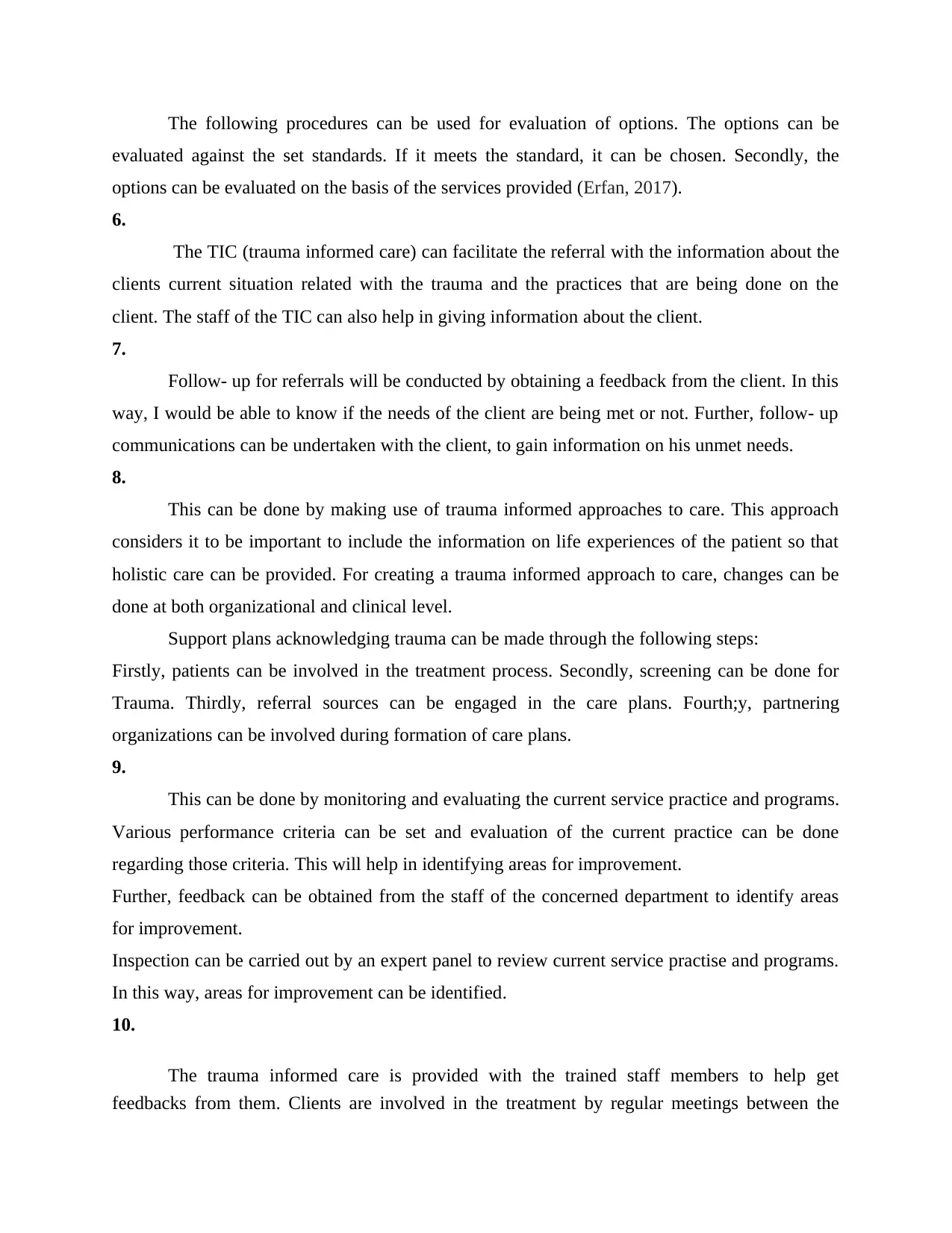
The following procedures can be used for evaluation of options. The options can be
evaluated against the set standards. If it meets the standard, it can be chosen. Secondly, the
options can be evaluated on the basis of the services provided (Erfan, 2017).
6.
The TIC (trauma informed care) can facilitate the referral with the information about the
clients current situation related with the trauma and the practices that are being done on the
client. The staff of the TIC can also help in giving information about the client.
7.
Follow- up for referrals will be conducted by obtaining a feedback from the client. In this
way, I would be able to know if the needs of the client are being met or not. Further, follow- up
communications can be undertaken with the client, to gain information on his unmet needs.
8.
This can be done by making use of trauma informed approaches to care. This approach
considers it to be important to include the information on life experiences of the patient so that
holistic care can be provided. For creating a trauma informed approach to care, changes can be
done at both organizational and clinical level.
Support plans acknowledging trauma can be made through the following steps:
Firstly, patients can be involved in the treatment process. Secondly, screening can be done for
Trauma. Thirdly, referral sources can be engaged in the care plans. Fourth;y, partnering
organizations can be involved during formation of care plans.
9.
This can be done by monitoring and evaluating the current service practice and programs.
Various performance criteria can be set and evaluation of the current practice can be done
regarding those criteria. This will help in identifying areas for improvement.
Further, feedback can be obtained from the staff of the concerned department to identify areas
for improvement.
Inspection can be carried out by an expert panel to review current service practise and programs.
In this way, areas for improvement can be identified.
10.
The trauma informed care is provided with the trained staff members to help get
feedbacks from them. Clients are involved in the treatment by regular meetings between the
evaluated against the set standards. If it meets the standard, it can be chosen. Secondly, the
options can be evaluated on the basis of the services provided (Erfan, 2017).
6.
The TIC (trauma informed care) can facilitate the referral with the information about the
clients current situation related with the trauma and the practices that are being done on the
client. The staff of the TIC can also help in giving information about the client.
7.
Follow- up for referrals will be conducted by obtaining a feedback from the client. In this
way, I would be able to know if the needs of the client are being met or not. Further, follow- up
communications can be undertaken with the client, to gain information on his unmet needs.
8.
This can be done by making use of trauma informed approaches to care. This approach
considers it to be important to include the information on life experiences of the patient so that
holistic care can be provided. For creating a trauma informed approach to care, changes can be
done at both organizational and clinical level.
Support plans acknowledging trauma can be made through the following steps:
Firstly, patients can be involved in the treatment process. Secondly, screening can be done for
Trauma. Thirdly, referral sources can be engaged in the care plans. Fourth;y, partnering
organizations can be involved during formation of care plans.
9.
This can be done by monitoring and evaluating the current service practice and programs.
Various performance criteria can be set and evaluation of the current practice can be done
regarding those criteria. This will help in identifying areas for improvement.
Further, feedback can be obtained from the staff of the concerned department to identify areas
for improvement.
Inspection can be carried out by an expert panel to review current service practise and programs.
In this way, areas for improvement can be identified.
10.
The trauma informed care is provided with the trained staff members to help get
feedbacks from them. Clients are involved in the treatment by regular meetings between the
Paraphrase This Document
Need a fresh take? Get an instant paraphrase of this document with our AI Paraphraser
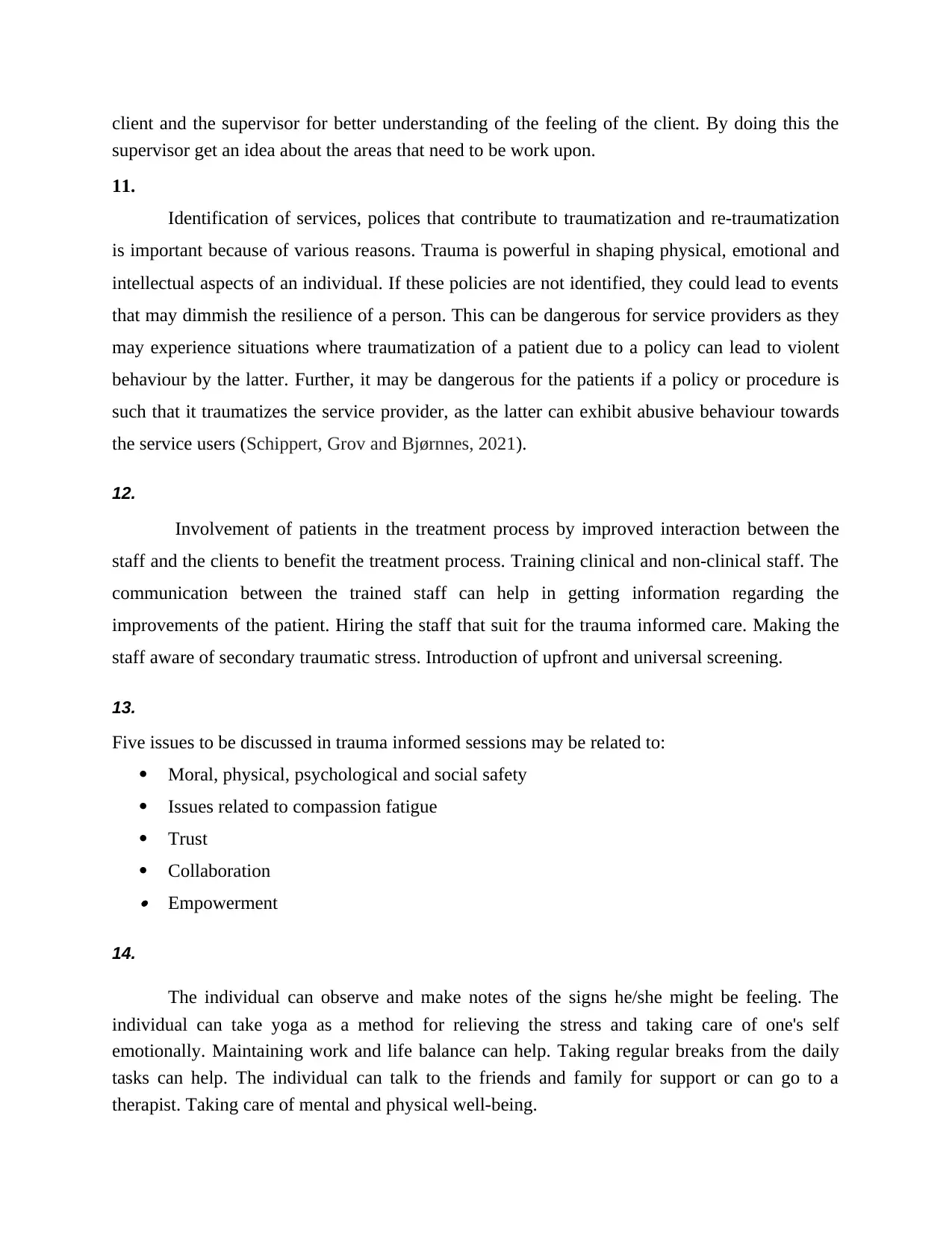
client and the supervisor for better understanding of the feeling of the client. By doing this the
supervisor get an idea about the areas that need to be work upon.
11.
Identification of services, polices that contribute to traumatization and re-traumatization
is important because of various reasons. Trauma is powerful in shaping physical, emotional and
intellectual aspects of an individual. If these policies are not identified, they could lead to events
that may dimmish the resilience of a person. This can be dangerous for service providers as they
may experience situations where traumatization of a patient due to a policy can lead to violent
behaviour by the latter. Further, it may be dangerous for the patients if a policy or procedure is
such that it traumatizes the service provider, as the latter can exhibit abusive behaviour towards
the service users (Schippert, Grov and Bjørnnes, 2021).
12.
Involvement of patients in the treatment process by improved interaction between the
staff and the clients to benefit the treatment process. Training clinical and non-clinical staff. The
communication between the trained staff can help in getting information regarding the
improvements of the patient. Hiring the staff that suit for the trauma informed care. Making the
staff aware of secondary traumatic stress. Introduction of upfront and universal screening.
13.
Five issues to be discussed in trauma informed sessions may be related to:
Moral, physical, psychological and social safety
Issues related to compassion fatigue
Trust
Collaboration Empowerment
14.
The individual can observe and make notes of the signs he/she might be feeling. The
individual can take yoga as a method for relieving the stress and taking care of one's self
emotionally. Maintaining work and life balance can help. Taking regular breaks from the daily
tasks can help. The individual can talk to the friends and family for support or can go to a
therapist. Taking care of mental and physical well-being.
supervisor get an idea about the areas that need to be work upon.
11.
Identification of services, polices that contribute to traumatization and re-traumatization
is important because of various reasons. Trauma is powerful in shaping physical, emotional and
intellectual aspects of an individual. If these policies are not identified, they could lead to events
that may dimmish the resilience of a person. This can be dangerous for service providers as they
may experience situations where traumatization of a patient due to a policy can lead to violent
behaviour by the latter. Further, it may be dangerous for the patients if a policy or procedure is
such that it traumatizes the service provider, as the latter can exhibit abusive behaviour towards
the service users (Schippert, Grov and Bjørnnes, 2021).
12.
Involvement of patients in the treatment process by improved interaction between the
staff and the clients to benefit the treatment process. Training clinical and non-clinical staff. The
communication between the trained staff can help in getting information regarding the
improvements of the patient. Hiring the staff that suit for the trauma informed care. Making the
staff aware of secondary traumatic stress. Introduction of upfront and universal screening.
13.
Five issues to be discussed in trauma informed sessions may be related to:
Moral, physical, psychological and social safety
Issues related to compassion fatigue
Trust
Collaboration Empowerment
14.
The individual can observe and make notes of the signs he/she might be feeling. The
individual can take yoga as a method for relieving the stress and taking care of one's self
emotionally. Maintaining work and life balance can help. Taking regular breaks from the daily
tasks can help. The individual can talk to the friends and family for support or can go to a
therapist. Taking care of mental and physical well-being.
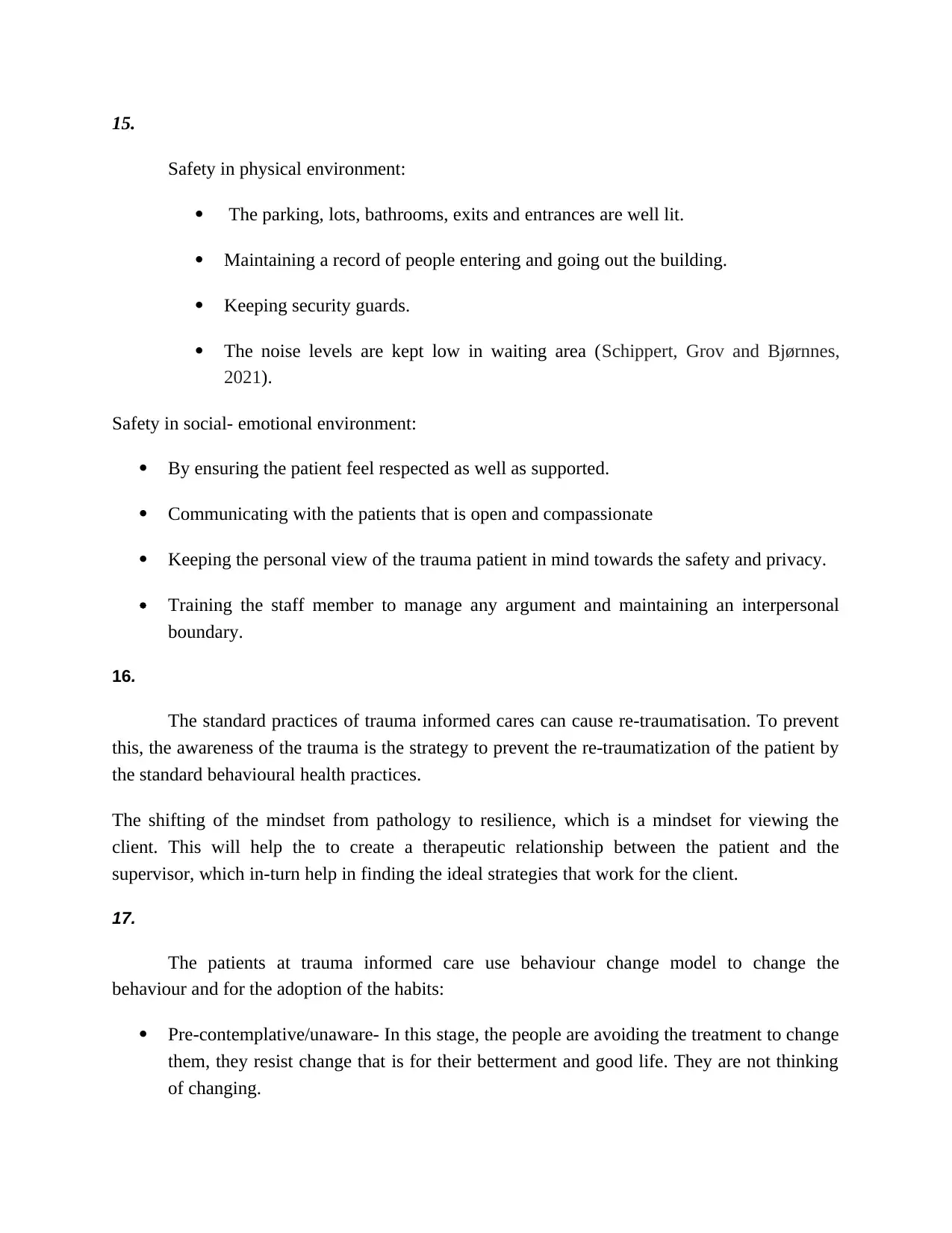
15.
Safety in physical environment:
The parking, lots, bathrooms, exits and entrances are well lit.
Maintaining a record of people entering and going out the building.
Keeping security guards.
The noise levels are kept low in waiting area (Schippert, Grov and Bjørnnes,
2021).
Safety in social- emotional environment:
By ensuring the patient feel respected as well as supported.
Communicating with the patients that is open and compassionate
Keeping the personal view of the trauma patient in mind towards the safety and privacy.
Training the staff member to manage any argument and maintaining an interpersonal
boundary.
16.
The standard practices of trauma informed cares can cause re-traumatisation. To prevent
this, the awareness of the trauma is the strategy to prevent the re-traumatization of the patient by
the standard behavioural health practices.
The shifting of the mindset from pathology to resilience, which is a mindset for viewing the
client. This will help the to create a therapeutic relationship between the patient and the
supervisor, which in-turn help in finding the ideal strategies that work for the client.
17.
The patients at trauma informed care use behaviour change model to change the
behaviour and for the adoption of the habits:
Pre-contemplative/unaware- In this stage, the people are avoiding the treatment to change
them, they resist change that is for their betterment and good life. They are not thinking
of changing.
Safety in physical environment:
The parking, lots, bathrooms, exits and entrances are well lit.
Maintaining a record of people entering and going out the building.
Keeping security guards.
The noise levels are kept low in waiting area (Schippert, Grov and Bjørnnes,
2021).
Safety in social- emotional environment:
By ensuring the patient feel respected as well as supported.
Communicating with the patients that is open and compassionate
Keeping the personal view of the trauma patient in mind towards the safety and privacy.
Training the staff member to manage any argument and maintaining an interpersonal
boundary.
16.
The standard practices of trauma informed cares can cause re-traumatisation. To prevent
this, the awareness of the trauma is the strategy to prevent the re-traumatization of the patient by
the standard behavioural health practices.
The shifting of the mindset from pathology to resilience, which is a mindset for viewing the
client. This will help the to create a therapeutic relationship between the patient and the
supervisor, which in-turn help in finding the ideal strategies that work for the client.
17.
The patients at trauma informed care use behaviour change model to change the
behaviour and for the adoption of the habits:
Pre-contemplative/unaware- In this stage, the people are avoiding the treatment to change
them, they resist change that is for their betterment and good life. They are not thinking
of changing.
⊘ This is a preview!⊘
Do you want full access?
Subscribe today to unlock all pages.

Trusted by 1+ million students worldwide
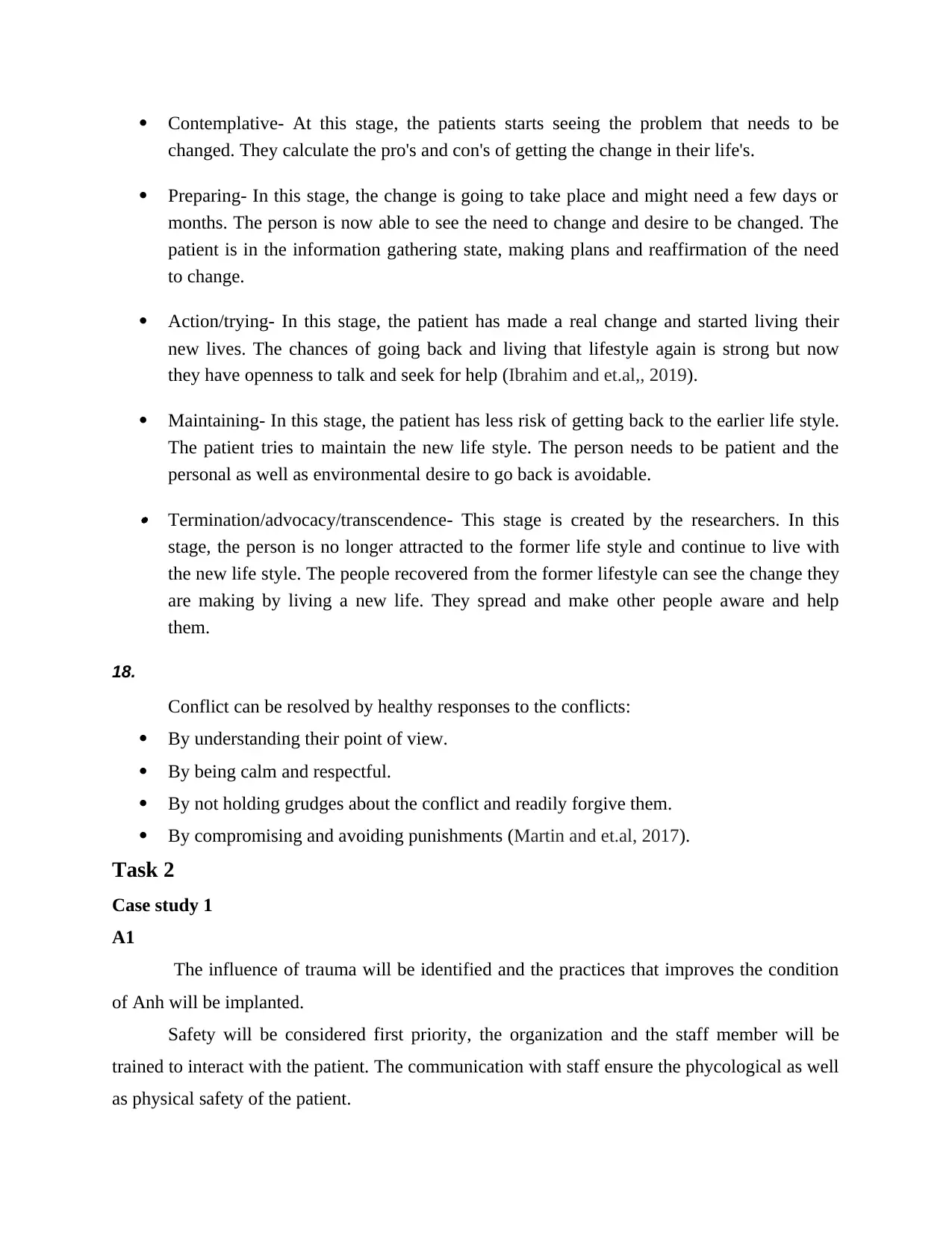
Contemplative- At this stage, the patients starts seeing the problem that needs to be
changed. They calculate the pro's and con's of getting the change in their life's.
Preparing- In this stage, the change is going to take place and might need a few days or
months. The person is now able to see the need to change and desire to be changed. The
patient is in the information gathering state, making plans and reaffirmation of the need
to change.
Action/trying- In this stage, the patient has made a real change and started living their
new lives. The chances of going back and living that lifestyle again is strong but now
they have openness to talk and seek for help (Ibrahim and et.al,, 2019).
Maintaining- In this stage, the patient has less risk of getting back to the earlier life style.
The patient tries to maintain the new life style. The person needs to be patient and the
personal as well as environmental desire to go back is avoidable. Termination/advocacy/transcendence- This stage is created by the researchers. In this
stage, the person is no longer attracted to the former life style and continue to live with
the new life style. The people recovered from the former lifestyle can see the change they
are making by living a new life. They spread and make other people aware and help
them.
18.
Conflict can be resolved by healthy responses to the conflicts:
By understanding their point of view.
By being calm and respectful.
By not holding grudges about the conflict and readily forgive them.
By compromising and avoiding punishments (Martin and et.al, 2017).
Task 2
Case study 1
A1
The influence of trauma will be identified and the practices that improves the condition
of Anh will be implanted.
Safety will be considered first priority, the organization and the staff member will be
trained to interact with the patient. The communication with staff ensure the phycological as well
as physical safety of the patient.
changed. They calculate the pro's and con's of getting the change in their life's.
Preparing- In this stage, the change is going to take place and might need a few days or
months. The person is now able to see the need to change and desire to be changed. The
patient is in the information gathering state, making plans and reaffirmation of the need
to change.
Action/trying- In this stage, the patient has made a real change and started living their
new lives. The chances of going back and living that lifestyle again is strong but now
they have openness to talk and seek for help (Ibrahim and et.al,, 2019).
Maintaining- In this stage, the patient has less risk of getting back to the earlier life style.
The patient tries to maintain the new life style. The person needs to be patient and the
personal as well as environmental desire to go back is avoidable. Termination/advocacy/transcendence- This stage is created by the researchers. In this
stage, the person is no longer attracted to the former life style and continue to live with
the new life style. The people recovered from the former lifestyle can see the change they
are making by living a new life. They spread and make other people aware and help
them.
18.
Conflict can be resolved by healthy responses to the conflicts:
By understanding their point of view.
By being calm and respectful.
By not holding grudges about the conflict and readily forgive them.
By compromising and avoiding punishments (Martin and et.al, 2017).
Task 2
Case study 1
A1
The influence of trauma will be identified and the practices that improves the condition
of Anh will be implanted.
Safety will be considered first priority, the organization and the staff member will be
trained to interact with the patient. The communication with staff ensure the phycological as well
as physical safety of the patient.
Paraphrase This Document
Need a fresh take? Get an instant paraphrase of this document with our AI Paraphraser
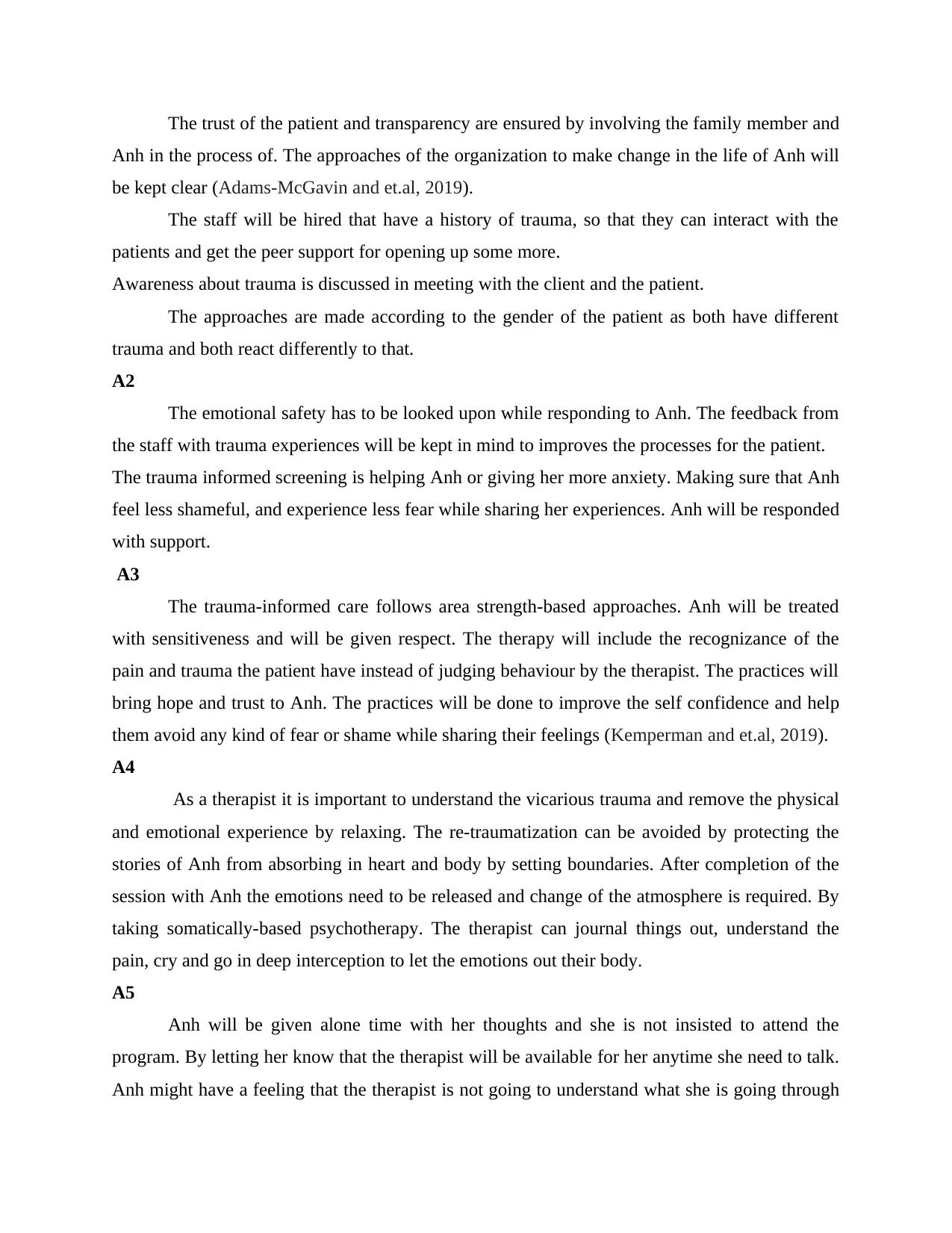
The trust of the patient and transparency are ensured by involving the family member and
Anh in the process of. The approaches of the organization to make change in the life of Anh will
be kept clear (Adams-McGavin and et.al, 2019).
The staff will be hired that have a history of trauma, so that they can interact with the
patients and get the peer support for opening up some more.
Awareness about trauma is discussed in meeting with the client and the patient.
The approaches are made according to the gender of the patient as both have different
trauma and both react differently to that.
A2
The emotional safety has to be looked upon while responding to Anh. The feedback from
the staff with trauma experiences will be kept in mind to improves the processes for the patient.
The trauma informed screening is helping Anh or giving her more anxiety. Making sure that Anh
feel less shameful, and experience less fear while sharing her experiences. Anh will be responded
with support.
A3
The trauma-informed care follows area strength-based approaches. Anh will be treated
with sensitiveness and will be given respect. The therapy will include the recognizance of the
pain and trauma the patient have instead of judging behaviour by the therapist. The practices will
bring hope and trust to Anh. The practices will be done to improve the self confidence and help
them avoid any kind of fear or shame while sharing their feelings (Kemperman and et.al, 2019).
A4
As a therapist it is important to understand the vicarious trauma and remove the physical
and emotional experience by relaxing. The re-traumatization can be avoided by protecting the
stories of Anh from absorbing in heart and body by setting boundaries. After completion of the
session with Anh the emotions need to be released and change of the atmosphere is required. By
taking somatically-based psychotherapy. The therapist can journal things out, understand the
pain, cry and go in deep interception to let the emotions out their body.
A5
Anh will be given alone time with her thoughts and she is not insisted to attend the
program. By letting her know that the therapist will be available for her anytime she need to talk.
Anh might have a feeling that the therapist is not going to understand what she is going through
Anh in the process of. The approaches of the organization to make change in the life of Anh will
be kept clear (Adams-McGavin and et.al, 2019).
The staff will be hired that have a history of trauma, so that they can interact with the
patients and get the peer support for opening up some more.
Awareness about trauma is discussed in meeting with the client and the patient.
The approaches are made according to the gender of the patient as both have different
trauma and both react differently to that.
A2
The emotional safety has to be looked upon while responding to Anh. The feedback from
the staff with trauma experiences will be kept in mind to improves the processes for the patient.
The trauma informed screening is helping Anh or giving her more anxiety. Making sure that Anh
feel less shameful, and experience less fear while sharing her experiences. Anh will be responded
with support.
A3
The trauma-informed care follows area strength-based approaches. Anh will be treated
with sensitiveness and will be given respect. The therapy will include the recognizance of the
pain and trauma the patient have instead of judging behaviour by the therapist. The practices will
bring hope and trust to Anh. The practices will be done to improve the self confidence and help
them avoid any kind of fear or shame while sharing their feelings (Kemperman and et.al, 2019).
A4
As a therapist it is important to understand the vicarious trauma and remove the physical
and emotional experience by relaxing. The re-traumatization can be avoided by protecting the
stories of Anh from absorbing in heart and body by setting boundaries. After completion of the
session with Anh the emotions need to be released and change of the atmosphere is required. By
taking somatically-based psychotherapy. The therapist can journal things out, understand the
pain, cry and go in deep interception to let the emotions out their body.
A5
Anh will be given alone time with her thoughts and she is not insisted to attend the
program. By letting her know that the therapist will be available for her anytime she need to talk.
Anh might have a feeling that the therapist is not going to understand what she is going through
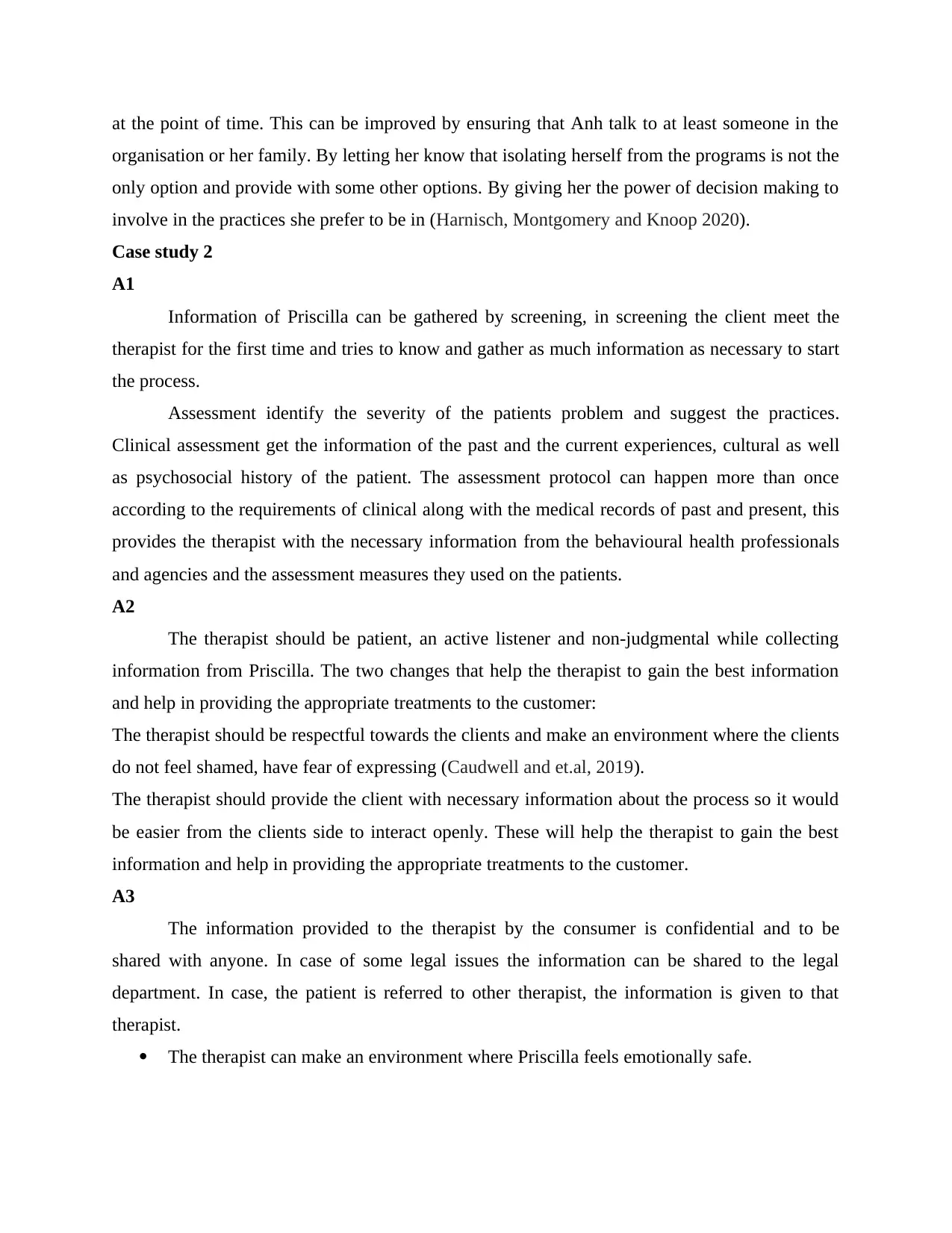
at the point of time. This can be improved by ensuring that Anh talk to at least someone in the
organisation or her family. By letting her know that isolating herself from the programs is not the
only option and provide with some other options. By giving her the power of decision making to
involve in the practices she prefer to be in (Harnisch, Montgomery and Knoop 2020).
Case study 2
A1
Information of Priscilla can be gathered by screening, in screening the client meet the
therapist for the first time and tries to know and gather as much information as necessary to start
the process.
Assessment identify the severity of the patients problem and suggest the practices.
Clinical assessment get the information of the past and the current experiences, cultural as well
as psychosocial history of the patient. The assessment protocol can happen more than once
according to the requirements of clinical along with the medical records of past and present, this
provides the therapist with the necessary information from the behavioural health professionals
and agencies and the assessment measures they used on the patients.
A2
The therapist should be patient, an active listener and non-judgmental while collecting
information from Priscilla. The two changes that help the therapist to gain the best information
and help in providing the appropriate treatments to the customer:
The therapist should be respectful towards the clients and make an environment where the clients
do not feel shamed, have fear of expressing (Caudwell and et.al, 2019).
The therapist should provide the client with necessary information about the process so it would
be easier from the clients side to interact openly. These will help the therapist to gain the best
information and help in providing the appropriate treatments to the customer.
A3
The information provided to the therapist by the consumer is confidential and to be
shared with anyone. In case of some legal issues the information can be shared to the legal
department. In case, the patient is referred to other therapist, the information is given to that
therapist.
The therapist can make an environment where Priscilla feels emotionally safe.
organisation or her family. By letting her know that isolating herself from the programs is not the
only option and provide with some other options. By giving her the power of decision making to
involve in the practices she prefer to be in (Harnisch, Montgomery and Knoop 2020).
Case study 2
A1
Information of Priscilla can be gathered by screening, in screening the client meet the
therapist for the first time and tries to know and gather as much information as necessary to start
the process.
Assessment identify the severity of the patients problem and suggest the practices.
Clinical assessment get the information of the past and the current experiences, cultural as well
as psychosocial history of the patient. The assessment protocol can happen more than once
according to the requirements of clinical along with the medical records of past and present, this
provides the therapist with the necessary information from the behavioural health professionals
and agencies and the assessment measures they used on the patients.
A2
The therapist should be patient, an active listener and non-judgmental while collecting
information from Priscilla. The two changes that help the therapist to gain the best information
and help in providing the appropriate treatments to the customer:
The therapist should be respectful towards the clients and make an environment where the clients
do not feel shamed, have fear of expressing (Caudwell and et.al, 2019).
The therapist should provide the client with necessary information about the process so it would
be easier from the clients side to interact openly. These will help the therapist to gain the best
information and help in providing the appropriate treatments to the customer.
A3
The information provided to the therapist by the consumer is confidential and to be
shared with anyone. In case of some legal issues the information can be shared to the legal
department. In case, the patient is referred to other therapist, the information is given to that
therapist.
The therapist can make an environment where Priscilla feels emotionally safe.
⊘ This is a preview!⊘
Do you want full access?
Subscribe today to unlock all pages.

Trusted by 1+ million students worldwide
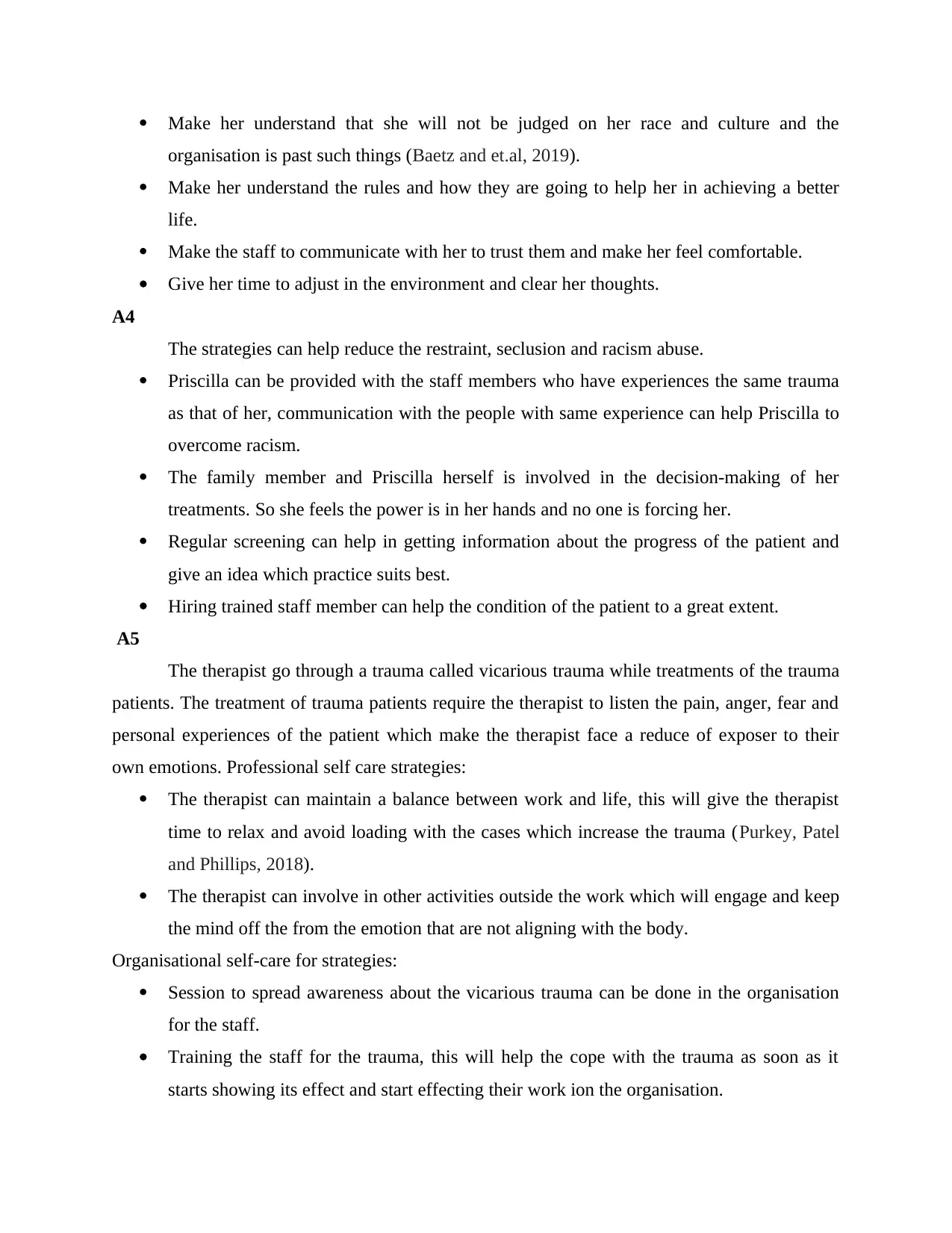
Make her understand that she will not be judged on her race and culture and the
organisation is past such things (Baetz and et.al, 2019).
Make her understand the rules and how they are going to help her in achieving a better
life.
Make the staff to communicate with her to trust them and make her feel comfortable.
Give her time to adjust in the environment and clear her thoughts.
A4
The strategies can help reduce the restraint, seclusion and racism abuse.
Priscilla can be provided with the staff members who have experiences the same trauma
as that of her, communication with the people with same experience can help Priscilla to
overcome racism.
The family member and Priscilla herself is involved in the decision-making of her
treatments. So she feels the power is in her hands and no one is forcing her.
Regular screening can help in getting information about the progress of the patient and
give an idea which practice suits best.
Hiring trained staff member can help the condition of the patient to a great extent.
A5
The therapist go through a trauma called vicarious trauma while treatments of the trauma
patients. The treatment of trauma patients require the therapist to listen the pain, anger, fear and
personal experiences of the patient which make the therapist face a reduce of exposer to their
own emotions. Professional self care strategies:
The therapist can maintain a balance between work and life, this will give the therapist
time to relax and avoid loading with the cases which increase the trauma (Purkey, Patel
and Phillips, 2018).
The therapist can involve in other activities outside the work which will engage and keep
the mind off the from the emotion that are not aligning with the body.
Organisational self-care for strategies:
Session to spread awareness about the vicarious trauma can be done in the organisation
for the staff.
Training the staff for the trauma, this will help the cope with the trauma as soon as it
starts showing its effect and start effecting their work ion the organisation.
organisation is past such things (Baetz and et.al, 2019).
Make her understand the rules and how they are going to help her in achieving a better
life.
Make the staff to communicate with her to trust them and make her feel comfortable.
Give her time to adjust in the environment and clear her thoughts.
A4
The strategies can help reduce the restraint, seclusion and racism abuse.
Priscilla can be provided with the staff members who have experiences the same trauma
as that of her, communication with the people with same experience can help Priscilla to
overcome racism.
The family member and Priscilla herself is involved in the decision-making of her
treatments. So she feels the power is in her hands and no one is forcing her.
Regular screening can help in getting information about the progress of the patient and
give an idea which practice suits best.
Hiring trained staff member can help the condition of the patient to a great extent.
A5
The therapist go through a trauma called vicarious trauma while treatments of the trauma
patients. The treatment of trauma patients require the therapist to listen the pain, anger, fear and
personal experiences of the patient which make the therapist face a reduce of exposer to their
own emotions. Professional self care strategies:
The therapist can maintain a balance between work and life, this will give the therapist
time to relax and avoid loading with the cases which increase the trauma (Purkey, Patel
and Phillips, 2018).
The therapist can involve in other activities outside the work which will engage and keep
the mind off the from the emotion that are not aligning with the body.
Organisational self-care for strategies:
Session to spread awareness about the vicarious trauma can be done in the organisation
for the staff.
Training the staff for the trauma, this will help the cope with the trauma as soon as it
starts showing its effect and start effecting their work ion the organisation.
Paraphrase This Document
Need a fresh take? Get an instant paraphrase of this document with our AI Paraphraser
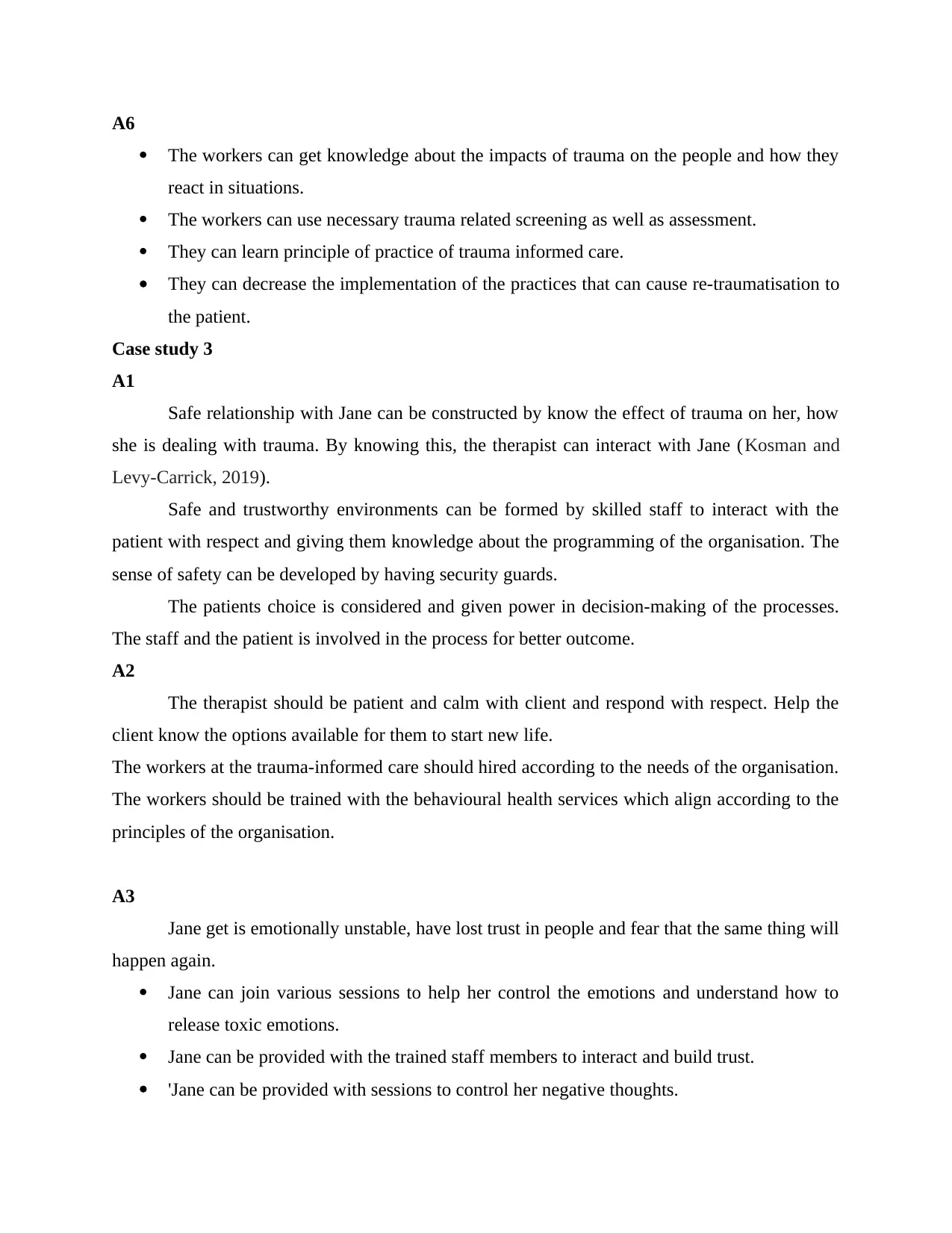
A6
The workers can get knowledge about the impacts of trauma on the people and how they
react in situations.
The workers can use necessary trauma related screening as well as assessment.
They can learn principle of practice of trauma informed care.
They can decrease the implementation of the practices that can cause re-traumatisation to
the patient.
Case study 3
A1
Safe relationship with Jane can be constructed by know the effect of trauma on her, how
she is dealing with trauma. By knowing this, the therapist can interact with Jane (Kosman and
Levy-Carrick, 2019).
Safe and trustworthy environments can be formed by skilled staff to interact with the
patient with respect and giving them knowledge about the programming of the organisation. The
sense of safety can be developed by having security guards.
The patients choice is considered and given power in decision-making of the processes.
The staff and the patient is involved in the process for better outcome.
A2
The therapist should be patient and calm with client and respond with respect. Help the
client know the options available for them to start new life.
The workers at the trauma-informed care should hired according to the needs of the organisation.
The workers should be trained with the behavioural health services which align according to the
principles of the organisation.
A3
Jane get is emotionally unstable, have lost trust in people and fear that the same thing will
happen again.
Jane can join various sessions to help her control the emotions and understand how to
release toxic emotions.
Jane can be provided with the trained staff members to interact and build trust.
'Jane can be provided with sessions to control her negative thoughts.
The workers can get knowledge about the impacts of trauma on the people and how they
react in situations.
The workers can use necessary trauma related screening as well as assessment.
They can learn principle of practice of trauma informed care.
They can decrease the implementation of the practices that can cause re-traumatisation to
the patient.
Case study 3
A1
Safe relationship with Jane can be constructed by know the effect of trauma on her, how
she is dealing with trauma. By knowing this, the therapist can interact with Jane (Kosman and
Levy-Carrick, 2019).
Safe and trustworthy environments can be formed by skilled staff to interact with the
patient with respect and giving them knowledge about the programming of the organisation. The
sense of safety can be developed by having security guards.
The patients choice is considered and given power in decision-making of the processes.
The staff and the patient is involved in the process for better outcome.
A2
The therapist should be patient and calm with client and respond with respect. Help the
client know the options available for them to start new life.
The workers at the trauma-informed care should hired according to the needs of the organisation.
The workers should be trained with the behavioural health services which align according to the
principles of the organisation.
A3
Jane get is emotionally unstable, have lost trust in people and fear that the same thing will
happen again.
Jane can join various sessions to help her control the emotions and understand how to
release toxic emotions.
Jane can be provided with the trained staff members to interact and build trust.
'Jane can be provided with sessions to control her negative thoughts.
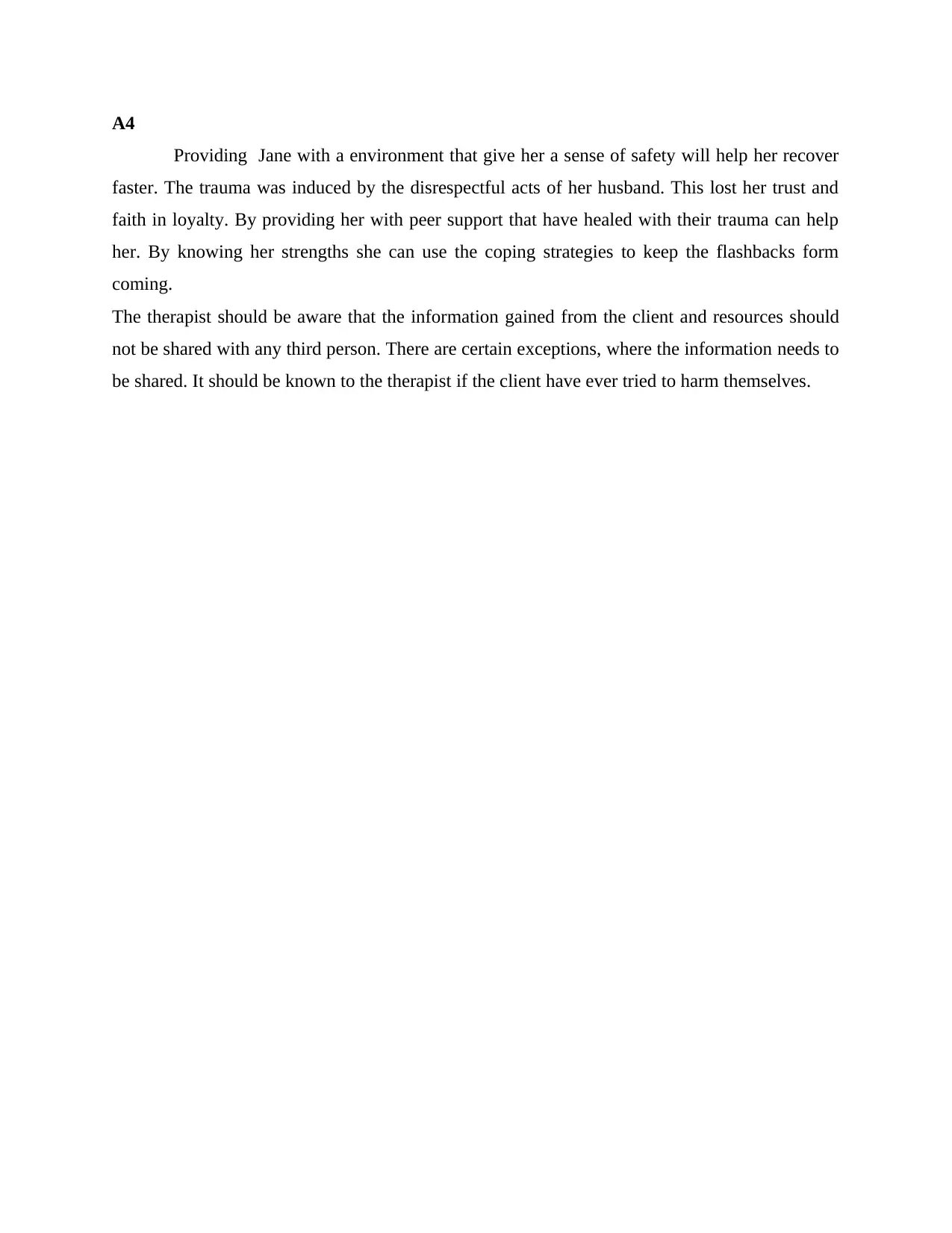
A4
Providing Jane with a environment that give her a sense of safety will help her recover
faster. The trauma was induced by the disrespectful acts of her husband. This lost her trust and
faith in loyalty. By providing her with peer support that have healed with their trauma can help
her. By knowing her strengths she can use the coping strategies to keep the flashbacks form
coming.
The therapist should be aware that the information gained from the client and resources should
not be shared with any third person. There are certain exceptions, where the information needs to
be shared. It should be known to the therapist if the client have ever tried to harm themselves.
Providing Jane with a environment that give her a sense of safety will help her recover
faster. The trauma was induced by the disrespectful acts of her husband. This lost her trust and
faith in loyalty. By providing her with peer support that have healed with their trauma can help
her. By knowing her strengths she can use the coping strategies to keep the flashbacks form
coming.
The therapist should be aware that the information gained from the client and resources should
not be shared with any third person. There are certain exceptions, where the information needs to
be shared. It should be known to the therapist if the client have ever tried to harm themselves.
⊘ This is a preview!⊘
Do you want full access?
Subscribe today to unlock all pages.

Trusted by 1+ million students worldwide
1 out of 14
Related Documents
Your All-in-One AI-Powered Toolkit for Academic Success.
+13062052269
info@desklib.com
Available 24*7 on WhatsApp / Email
![[object Object]](/_next/static/media/star-bottom.7253800d.svg)
Unlock your academic potential
Copyright © 2020–2025 A2Z Services. All Rights Reserved. Developed and managed by ZUCOL.




